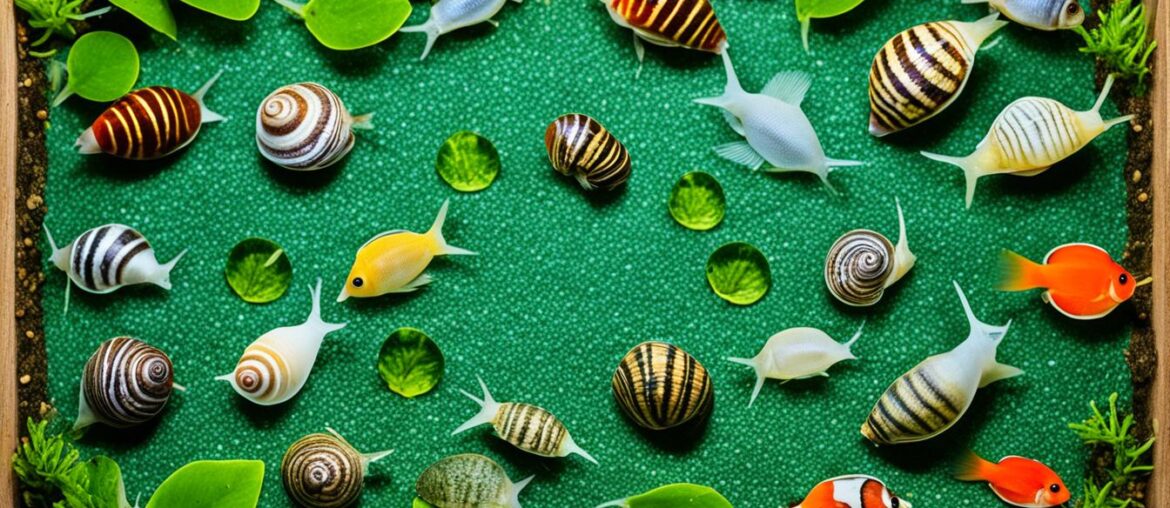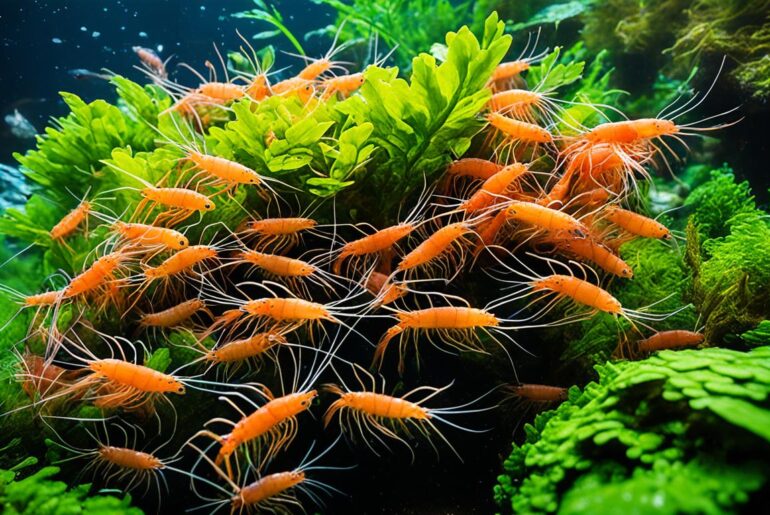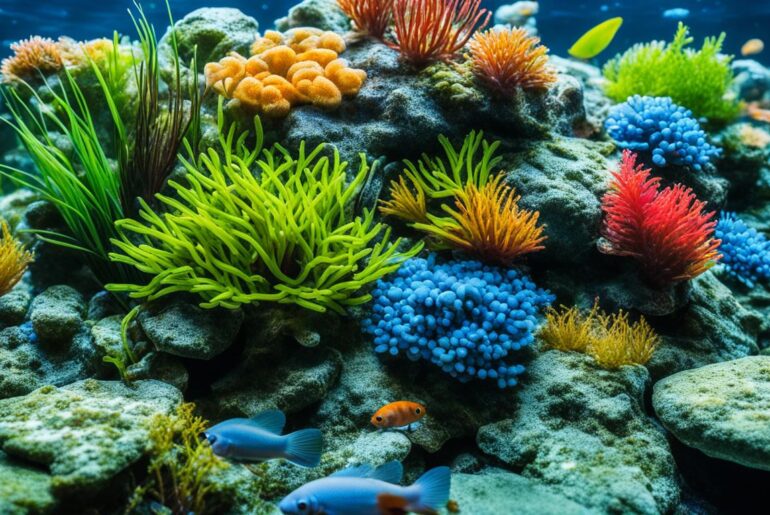Are you struggling to provide the right food for your freshwater aquarium snails? Do you often wonder if you’re feeding them enough or if their diet is balanced? Don’t worry, you’re not alone. Feeding freshwater snails can be a bit tricky, but with the right knowledge and guidance, you can ensure that your snails are well-fed and healthy.
In this article, I will take you through the 7 essential steps to feed your freshwater aquarium snails properly. From choosing the right food to establishing a feeding routine and maintaining a clean environment, you’ll discover all the secrets to keeping your snails happy and thriving.
Key Takeaways:
- Provide a balanced diet, including algae wafers, blanched vegetables, and high-quality fish flakes.
- Feed your snails twice a day, monitoring their response and adjusting the feeding amount accordingly.
- Use a feeding dish or clip to secure the food and prevent spreading.
- Maintain a stable temperature and environment for your snails’ well-being.
- Regularly clean the tank and remove any dead organisms to ensure water quality.
Choosing the Right Food for Freshwater Aquarium Snails
When it comes to feeding your freshwater aquarium snails, selecting the right food is vital for their overall health and well-being. Providing them with a balanced diet that mimics their natural food sources is essential. Algae wafers, for instance, are a popular choice as they closely resemble the algae and plants that snails consume in the wild. These wafers are rich in nutrients that promote healthy growth and support their dietary needs.
“A balanced diet is crucial for the health and growth of freshwater aquarium snails.”
In addition to algae wafers, you can include other foods in their diet to provide variety and ensure they receive a comprehensive nutritional profile. Blanched vegetables such as zucchini or spinach are excellent options. These are not only rich in essential vitamins and minerals but also provide a source of fiber for their digestive health. High-quality fish flakes and pellet food are also suitable alternatives, as they offer a balanced mix of proteins, fats, and carbohydrates.
“Offering a diverse diet ensures that your freshwater snails receive the necessary nutrients for optimal health.”
Feeding Tip:
Remember to vary the food you offer to your snails to ensure they receive a balanced, well-rounded diet. This will help keep them healthy and prevent any nutritional deficiencies.
It’s important to note that while snails have voracious appetites, it’s crucial to avoid overfeeding them. Overfeeding can lead to waste buildup and water quality issues. Therefore, it’s recommended to feed them an amount they can consume in a few minutes, and remove any uneaten food promptly.
“Proper feeding practices are vital to maintain a clean and healthy environment for your freshwater snails.”
Recommended Food Options for Freshwater Aquarium Snails
| Food | Nutritional Benefits |
|---|---|
| Algae Wafers | Mimics natural diet, rich in nutrients |
| Blanched vegetables (zucchini or spinach) | Source of vitamins, minerals, and fiber |
| High-quality fish flakes | Protein-rich, balanced nutritional profile |
| Pellet food | Convenient, balanced nutrition |
By choosing the right food options for your freshwater aquarium snails and providing them with a varied and nutritious diet, you can promote their overall well-being and ensure they thrive in their aquatic habitat.
Establishing a Feeding Routine for Aquarium Snails
Feeding your aquarium snails on a consistent schedule is essential to maintain their health and well-being. By establishing a feeding routine, you can ensure that your snails receive the right amount of food without overfeeding them. Here are some guidelines to help you create an effective feeding routine for your aquarium snails:
- Feed your snails once or twice a day. The frequency of feeding will depend on the specific needs of your snail species, but generally, providing food once in the morning and once in the evening is ideal.
- Give your snails an amount of food they can consume within a few minutes. This helps prevent food waste and avoids excessive buildup of uneaten food in the tank.
- Observe your snails’ feeding habits. Pay attention to how quickly they finish their food and adjust the quantity accordingly. If they finish the food too quickly or seem hungry, you can slightly increase the portion size.
- Remove any uneaten food from the tank after feeding. Leaving uneaten food in the tank can lead to water quality issues and can also attract pests or harmful bacteria.
Remember, providing a balanced diet and maintaining a clean environment are key factors in keeping your aquarium snails healthy and thriving.
For more detailed information on the feeding routine for aquarium snails, refer to the table below:
| Feeding Routine | Frequency | Recommended Portion Size |
|---|---|---|
| Morning Feed | Once a day, in the morning | An amount they can consume within 2-3 minutes |
| Evening Feed | Once a day, in the evening | An amount they can consume within 2-3 minutes |
Note: The feeding routine may vary depending on the specific species of snails you have. It’s always a good idea to research the dietary needs of your particular snail species and consult with experienced hobbyists or aquatic experts for personalized advice.
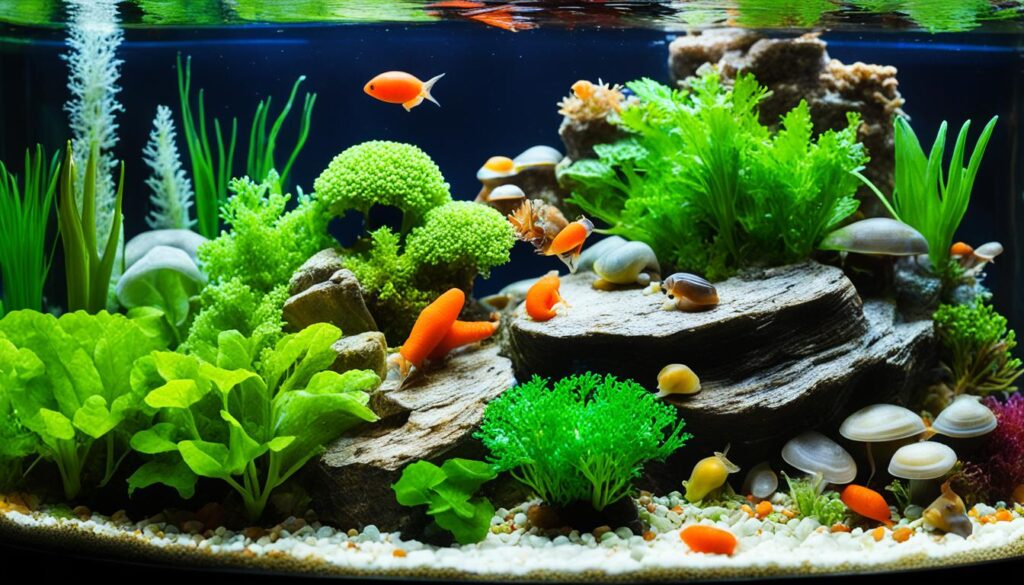
Establishing a regular feeding routine ensures that your aquarium snails receive proper nutrition while maintaining a clean and hygienic environment. By following these guidelines, you can promote the health and well-being of your snails, allowing them to thrive in their aquatic habitat.
Tips for Feeding Freshwater Snails
Here are some tips and techniques to ensure successful feeding for your freshwater snails:
- Use a feeding dish or clip: Consider using a feeding dish or clip to secure the food in one place, preventing it from spreading and making it easier for the snails to access.
- Monitor their feeding behavior: Pay attention to how your snails feed to determine their preferences. Adjust their diet accordingly to ensure they receive the food they enjoy the most.
- Ensure multiple snails have access to food: If you have multiple snails in your tank, make sure they all have access to food by spreading it around the tank. This ensures that each snail gets its fair share of nourishment.
- Avoid harmful chemicals: Snails can be sensitive to medications or products with harmful chemicals. Avoid using such substances in your tank to prevent any negative effects on your snails’ health.
- Provide calcium-rich foods or supplements: To support the shell growth and overall health of your freshwater snails, provide them with calcium-rich foods or supplements. This helps them maintain strong and healthy shells.
Expert Tip:
Observing your snails’ feeding habits is crucial for understanding their dietary needs. Experiment with different types of food to discover their preferences and ensure a varied and balanced diet.
Recap:
| Tips for Feeding Freshwater Snails |
|---|
| Use a feeding dish or clip to secure the food in one place |
| Monitor their feeding behavior and adjust their diet accordingly |
| Ensure multiple snails have access to food by spreading it around the tank |
| Avoid using medications or products with harmful chemicals |
| Provide calcium-rich foods or supplements for shell growth and health |
Water Preparation for Aquarium Snails
When it comes to keeping aquarium snails healthy, water preparation is essential. Tap water often contains chlorine, which can be harmful to these delicate creatures. Fortunately, there are a few methods to make tap water safe for your snails.
Treating tap water
To remove chlorine from tap water, you can try one of the following methods:
- Using bottled water: Purchase bottled water specifically labeled for aquarium use. This water has already been treated and is safe for your snails.
- Letting tap water sit: Fill a container with tap water and let it sit uncovered for 24 hours. During this time, the chlorine in the water will naturally evaporate.
- Water conditioner: Use a water conditioner that is specifically designed for aquarium use. Follow the instructions on the product label to treat the tap water before adding it to your tank.
Maintaining a stable pH
In addition to treating tap water, it’s important to maintain a stable pH level for your snails. A pH testing kit can help you monitor the acidity or alkalinity of the water. Snails generally prefer a slightly alkaline pH, around 7.5 to 8.5. Avoid sudden fluctuations in pH levels, as this can stress or even harm your snails. Take the necessary steps to stabilize the pH and provide a consistent environment for your snails.
To summarize, treating tap water and maintaining a stable pH are crucial for the well-being of your aquarium snails. These steps help create a safe and comfortable environment for your snails to thrive. Remember, healthy water leads to healthy snails!
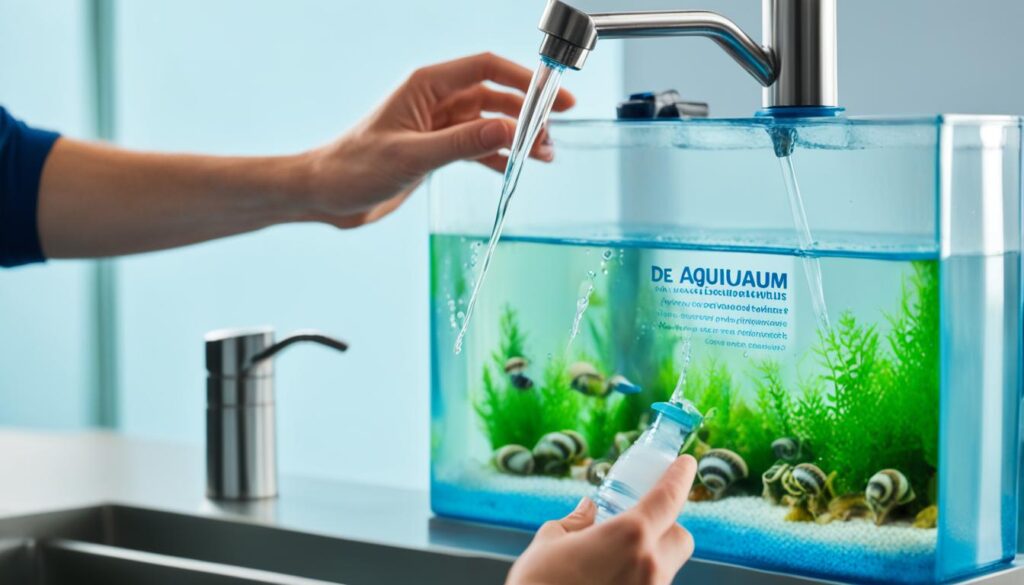
Did You Know?
“Proper water preparation is the key to ensuring the best possible environment for your aquarium snails – a little effort goes a long way!”
Tank Setup for Freshwater Aquarium Snails
Choosing an appropriate tank size and providing a suitable substrate are essential for creating a comfortable and thriving environment for your freshwater aquarium snails.
First, let’s determine the ideal tank size based on the number of snails you plan to keep. As a general guideline, it is recommended to allocate one gallon of water for every 5-10 small snails or one gallon for 2-3 large snails. This allows each snail to have enough space to roam and explore.
To further enhance their habitat, it’s important to provide a proper substrate at the bottom of the tank. Snails enjoy burrowing and foraging, so sand or fine gravel makes an excellent choice for many snail species. This substrate mimics their natural environment and allows them to engage in their natural behavior.
Having a tank with a secure lid is also crucial to prevent any adventurous snails from escaping. Ensure the lid fits tightly to keep your snails safe within their home.
Creating a suitable tank setup, including choosing the right tank size and substrate, will contribute to the overall well-being and happiness of your freshwater aquarium snails.
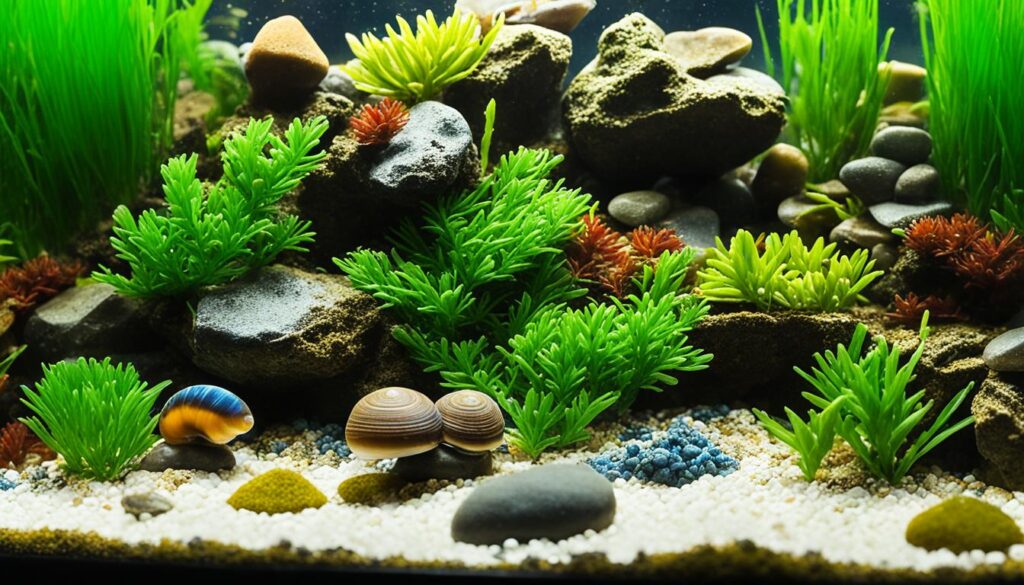
“Choosing the appropriate tank size and providing a suitable substrate are crucial aspects of setting up a freshwater aquarium for snails. These considerations directly impact the snails’ comfort and ability to thrive in their new environment.”
Maintaining Optimal Temperature and Environment for Snails
Proper temperature and environment are essential for the well-being of freshwater snails in your aquarium. Snails thrive in a temperature range of 72 to 82 degrees Fahrenheit (22 to 28 degrees Celsius), so it’s important to maintain a stable temperature within this range to ensure their comfort and health.
Avoid placing the tank in direct sunlight, as it can lead to temperature fluctuations that may stress the snails. Instead, position the tank in an area away from direct sunlight or use appropriate aquarium lighting to mimic their natural habitat.
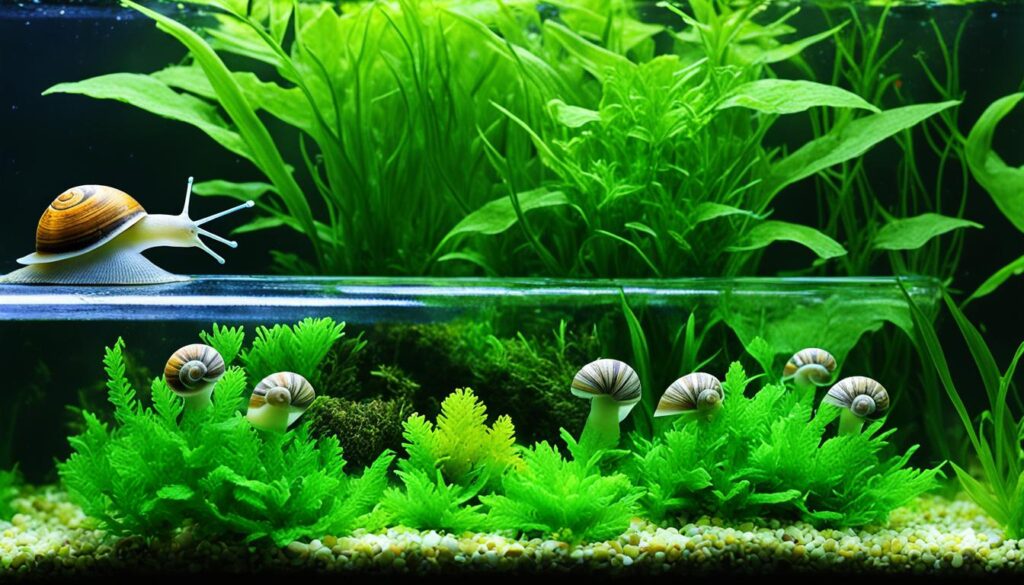
In addition to temperature, consider other factors that can affect the snail’s environment. These include the ambient temperature in your home and the climate of your region. If necessary, use aquarium heaters to regulate the temperature and create a stable environment for your snails.
Remember, maintaining a suitable temperature and environment is crucial for the well-being of your snails, so take the necessary steps to provide them with a comfortable and stress-free habitat.
Creating a Clean Environment for Freshwater Snails
Cleanliness is vital for maintaining the health of your freshwater aquarium snails. By ensuring a clean environment, you can promote their well-being and prevent the accumulation of harmful substances. Here are some essential tips for maintaining a clean aquarium for your snails:
Regular Inspection and Maintenance
Regularly check the tank water for any dead organisms and promptly remove them. Dead snails or other decaying matter can release toxins that can harm your snails and affect water quality. Additionally, if you notice that the water becomes cloudy or develops an unpleasant smell, it’s a clear indication that a water change is necessary.
Water Changes
Regular water changes are crucial for maintaining optimal water quality and preventing the build-up of harmful substances. Replace a portion of the water in your aquarium every week, ensuring it’s the appropriate temperature and properly treated to remove chlorine or other harmful chemicals. Aim to replace about 20-30% of the water volume with each water change.
Avoid Harmful Medications
When treating any issues in your aquarium, such as diseases or parasites, it’s essential to choose medications that are safe for freshwater snails. Some medications can be harmful or even fatal to snails, so always read and follow the instructions carefully. If you’re unsure about the compatibility of a medication with your snails, consult with an aquarium expert.
Cautious Use of Plant Fertilizers
If you have live plants in your aquarium, be cautious when using fertilizers. Some fertilizers may contain chemicals that can be harmful to snails. It’s important to research and choose fertilizers that are safe for both your plants and your snails. Monitor your snails’ behavior and health after introducing any fertilizers to ensure they are not negatively affected.
To maintain a clean and healthy environment for your freshwater snails, it’s crucial to practice regular inspection, maintenance, and water changes. Avoid using medications or fertilizers that can harm your snails and consult with experts when in doubt. By taking these steps, you’ll create an optimal environment for your snails to thrive and enjoy their time in your aquarium.
| Benefits of a Clean Environment for Freshwater Snails | Tips for Maintaining a Clean Aquarium |
|---|---|
| 1. Enhanced snail health: A clean environment promotes better health and longevity for your freshwater snails. | 1. Regular inspection: Perform regular checks for any dead organisms and promptly remove them. |
| 2. Preventing water quality issues: Regular maintenance and water changes help prevent poor water quality, reducing the risk of stress, illnesses, and even death. | 2. Water changes: Replace a portion of the water in your aquarium every week to maintain optimal water quality. |
| 3. Promoting overall tank cleanliness: A clean aquarium creates a visually appealing and enjoyable environment for both you and your snails. | 3. Avoid harmful medications: Choose medications that are safe for freshwater snails and follow the instructions carefully. |
| 4. Preventing algae growth: A clean environment minimizes excessive algae growth and helps prevent snails from overeating. | 4. Cautious use of plant fertilizers: Choose fertilizers that are safe for both your plants and your snails to avoid any adverse effects. |
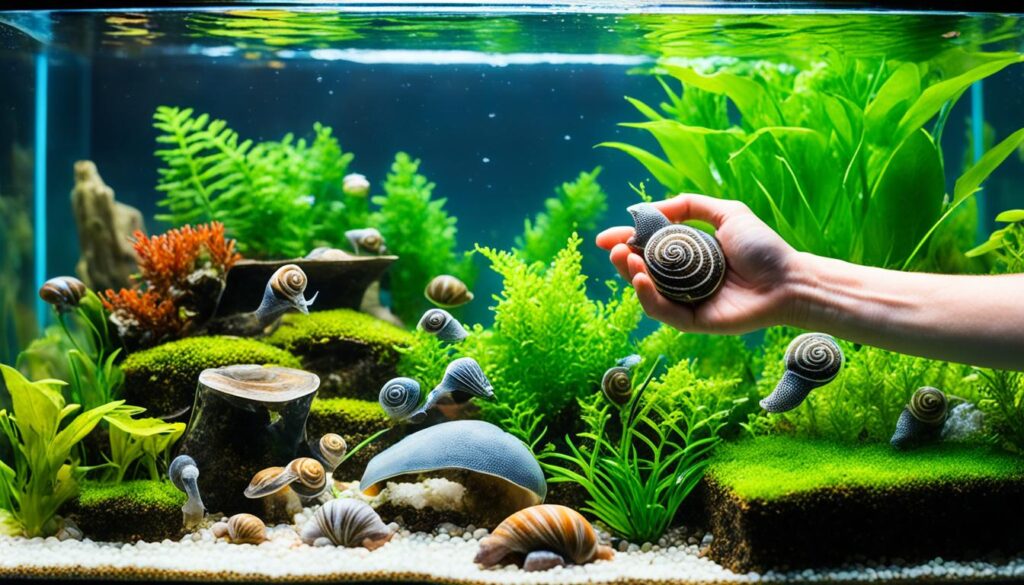
Types of Freshwater Snails and Their Care Requirements
There are several popular types of freshwater snails commonly kept in aquariums. These include Gold Inca, Mystery, Nerite, Pond, Ramshorn, and Trumpet snails. Each type has its own distinct features and care requirements. Gold Inca and Ivory snails are good cleaners of freshwater tanks, while Mystery and Nerite snails are known for their scavenging abilities. Pond, Ramshorn, and Trumpet snails are often unintentional additions to aquariums but can still serve beneficial purposes. Research the specific care requirements for the type of snail you choose to ensure their well-being.
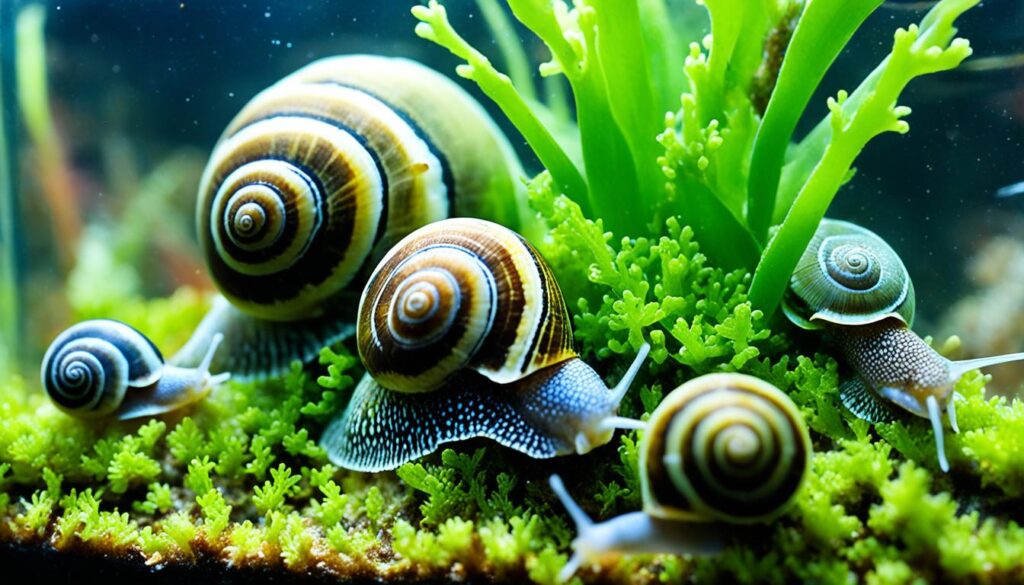
| Type of Snail | Features | Common Name | Care Requirements |
|---|---|---|---|
| Gold Inca Snail | Gold-colored shell Efficient algae eater Peaceful temperament |
Gold Inca Snail | Provide enough algae and vegetation to mimic their natural diet. Keep tank water clean. Monitor water parameters. |
| Mystery Snail | Vibrant and colorful shells Can reproduce in aquariums Solid waste control |
Mystery Snail | Place a calcium source in the tank for healthy shell growth. Regularly monitor water quality and temperature. Ensure sufficient food and plant matter for grazing. |
| Nerite Snail | Striped or spotted shells Excellent algae eaters Small adult size |
Nerite Snail | Provide ample algae supply for grazing. Avoid copper-based medications. Keep water parameters stable. |
| Pond Snail | Small size and low maintenance Can reproduce rapidly Scavengers |
Pond Snail | Control population to prevent overpopulation. Be cautious when introducing to aquariums. Provide additional food if natural grazing is insufficient. |
| Ramshorn Snail | Flat, disc-shaped shells Rapid reproduction Can adjust to different water conditions |
Ramshorn Snail | Control population to prevent overcrowding. Provide adequate vegetation for grazing. Regularly clean and maintain tank water. |
| Trumpet Snail | Spiral-shaped shells Efficient algae eater Burrowers |
Trumpet Snail | Regularly trim plants to control population growth. Avoid overfeeding to prevent population explosion. Keep tank water well-maintained. |
Types of Saltwater Snails for Marine Tanks
Saltwater snails are a popular choice for marine tanks due to their ability to contribute to the overall health of the ecosystem. These snails play a vital role in consuming algae and plant matter, helping to maintain a balanced environment. When selecting saltwater snails for your tank, it’s important to consider their unique characteristics and care requirements. Here are some popular saltwater snail species:
| Snail Species | Characteristics | Care Requirements |
|---|---|---|
| Bumble Bee Snails | Known for their striking black and yellow stripes, Bumble Bee snails are carnivorous and have the ability to eat other snails. | – Provide a varied diet of meaty foods such as shrimp pellets and fish flakes. – Ensure a stable water temperature between 72-78 degrees Fahrenheit (22-26 degrees Celsius). – Maintain proper water parameters, including salinity and pH levels. – Provide adequate hiding places for the snails, such as rocks or caves. – Avoid aggressive tankmates that may harass or harm the snails. |
| Malaysian Trumpet Snails | Malaysian Trumpet snails are known for their long, spiral shells and their ability to burrow into the substrate. | – Provide a sand or gravel substrate that allows the snails to burrow. – Feed them sinking pellets, algae wafers, and vegetable matter. – Maintain stable water parameters, including temperature, salinity, and pH. – Avoid overpopulation by controlling the number of snails in the tank. |
| Nerite Snails | Nerite snails are popular for their attractive patterns and their ability to consume algae, helping to keep the tank clean. | – Ensure a stable water temperature between 72-82 degrees Fahrenheit (22-28 degrees Celsius). – Provide an algae-rich diet, including algae wafers and spirulina flakes. – Maintain proper water parameters, including salinity and pH levels. – Be cautious with copper-based medications, as Nerite snails are sensitive to copper. – Provide a suitable substrate for the snails to explore and graze on. |
| Rabbit Snails | Rabbit snails are known for their rabbit-like appearance and large size. They can add a unique aesthetic to the marine tank. | – Provide a sand or fine gravel substrate to accommodate their burrowing behavior. – Feeding them a varied diet consisting of commercial sinking pellets, vegetables, and organic matter. – Maintain stable water parameters, including temperature, salinity, and pH. – Avoid exposing the snails to high levels of nitrate or ammonia in the water. – Monitor their behavior and health regularly to identify any potential issues. |
| Assassin Snails | Assassin snails are predatory snails that can be useful in controlling populations of unwanted snails, such as pest snails. | – Provide a sandy substrate for the snails to burrow and search for prey. – Ensure a stable water temperature between 75-82 degrees Fahrenheit (24-28 degrees Celsius). – Feed them a diet of meaty foods, including sinking pellets and freeze-dried worms. – Maintain proper water parameters, including salinity and pH levels. – Avoid keeping Assassin snails with smaller tankmates that may become prey. |
Research the specific needs of the saltwater snail species you choose to ensure proper care and create a thriving marine tank environment.
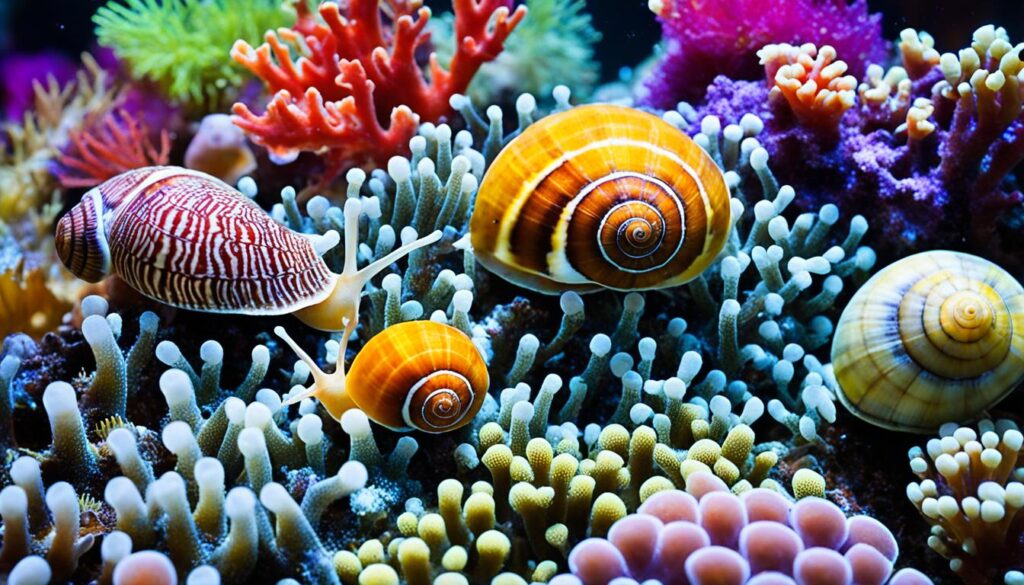
Acclimating Snails to Their New Environment
Properly acclimating aquarium snails to their new environment is crucial for their survival and well-being. When bringing home new snails, they are usually placed in a plastic bag filled with water from the pet store. To ensure a smooth transition, follow these steps:
- Float the bag in the tank water for 30 minutes. This allows the snails to gradually adjust to the temperature of the tank water.
- After 30 minutes, slowly add small amounts of tank water to the bag at regular intervals. This helps the snails acclimate to the water chemistry in the tank.
- Continue adding tank water to the bag over the course of an hour, gradually increasing the ratio of tank water to the original water in the bag.
- After the acclimation process is complete, carefully transfer the snails from the bag into the tank, ensuring not to introduce any of the bag water into the tank.
It’s important to monitor the behavior of the snails after acclimation. They should exhibit normal activity, such as moving and exploring their new surroundings. If you notice any signs of distress or abnormal behavior, consult with an aquarium expert to ensure the proper acclimation of your snails.
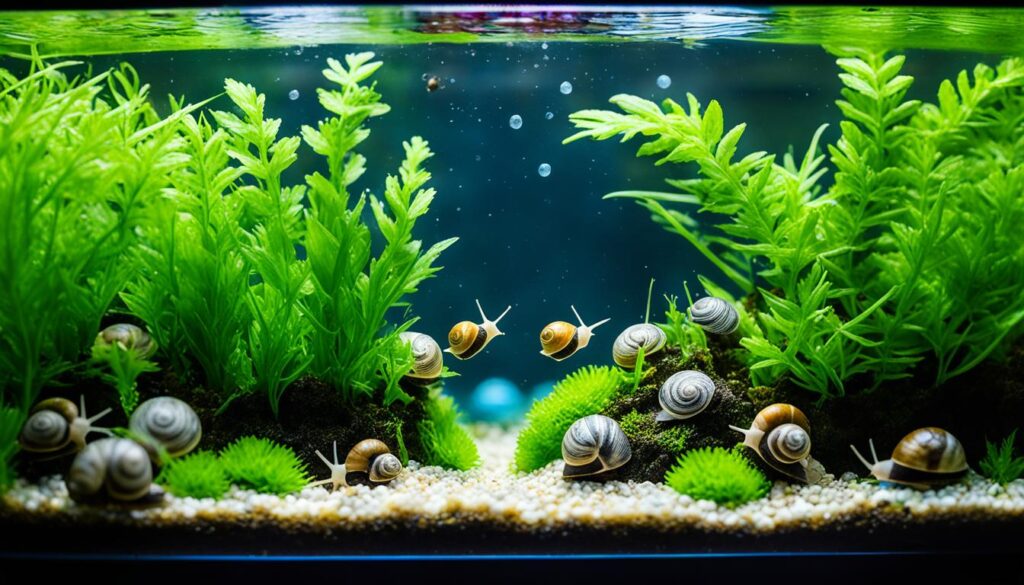
Acclimating snails to their new environment helps reduce stress and increases their chances of successfully adapting to the tank. Take the time to properly acclimate your snails to create a comfortable and healthy home for them.
Conclusion
Feeding your freshwater aquarium snails properly is essential to ensure their overall health and well-being. By following the guidelines provided in this freshwater snail feeding guide and incorporating snail care tips, you can provide the best possible care for your snails and help them thrive in their environment.
Remember to offer a varied and balanced diet that mimics their natural feeding habits. This can include algae wafers, blanched vegetables, high-quality fish flakes, and pellet food. Observing their feeding behavior and adjusting the amount of food accordingly is crucial to prevent overfeeding and maintain water quality.
In addition to proper feeding, establishing a feeding routine and maintaining a clean environment are essential factors for the health of your freshwater aquarium snails. Consistency in feeding schedule and the removal of uneaten food contribute to their overall well-being. Ensuring a stable water pH and temperature, as well as performing regular water changes, is vital for maintaining a healthy habitat.
By understanding the specific needs of different snail species and adapting their care accordingly, you can create an environment where your freshwater aquarium snails can thrive. With the right feeding and care, these snails can enhance the ecosystem of your tank, contributing to its overall balance and beauty.
FAQ
How often should I feed my freshwater aquarium snails?
It is recommended to feed your freshwater aquarium snails once or twice a day.
How much food should I give my freshwater snails?
Feed your snails an amount of food they can consume within a few minutes. Avoid overfeeding to prevent water quality issues.
What are the best foods for freshwater aquarium snails?
Freshwater aquarium snails enjoy grazing on plants, algae, and store-bought algae wafers. Other suitable options include blanched vegetables, high-quality fish flakes, and pellet food.
How do I establish a feeding routine for my aquarium snails?
Feed your snails once or twice a day at the same time, providing an amount they can consume within a few minutes. Monitor their feeding habits and adjust the frequency and amount of food accordingly.
Are there any tips for feeding freshwater snails?
Consider using a feeding dish or clip to secure the food, monitor their feeding preferences, ensure all snails have access to food, and provide calcium-rich foods or supplements for their shell growth.
How can I treat tap water for aquarium snails?
You can treat tap water by using bottled water, letting tap water sit for 24 hours to allow chlorine to evaporate, or using a water conditioner specifically designed for aquarium use.
What tank size is suitable for freshwater aquarium snails?
The tank size depends on the number of snails. It is generally recommended to have one gallon of water for every 5-10 small snails or one gallon for 2-3 large snails.
What temperature should I maintain for freshwater snails in my aquarium?
Freshwater snails thrive in a temperature range of 72 to 82 degrees Fahrenheit (22 to 28 degrees Celsius). Maintain a stable temperature within this range for their well-being.
How do I create a clean environment for freshwater snails?
Regularly check the tank for dead organisms, perform water changes when necessary, avoid harmful medications, and be cautious with plant fertilizers to maintain water quality.
What are the types of freshwater snails commonly kept in aquariums?
The types of freshwater snails commonly kept in aquariums include Gold Inca, Mystery, Nerite, Pond, Ramshorn, and Trumpet snails.
What types of saltwater snails are suitable for marine tanks?
Some popular saltwater snail species include Bumble Bee, Malaysian Trumpet, Nerite, Rabbit, and Assassin snails.
How do I acclimate snails to their new environment?
Acclimate snails by floating the bag in the tank water for 30 minutes, gradually replacing the bag water with tank water over an hour, and monitoring their behavior during the transition.
